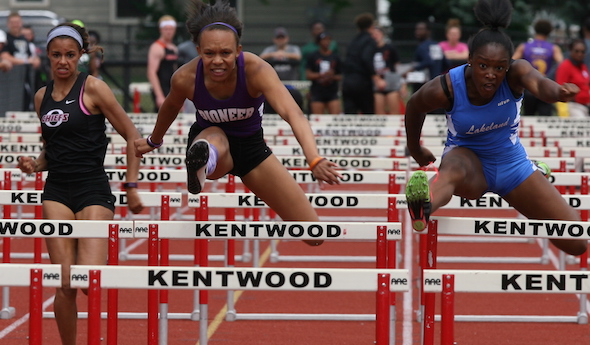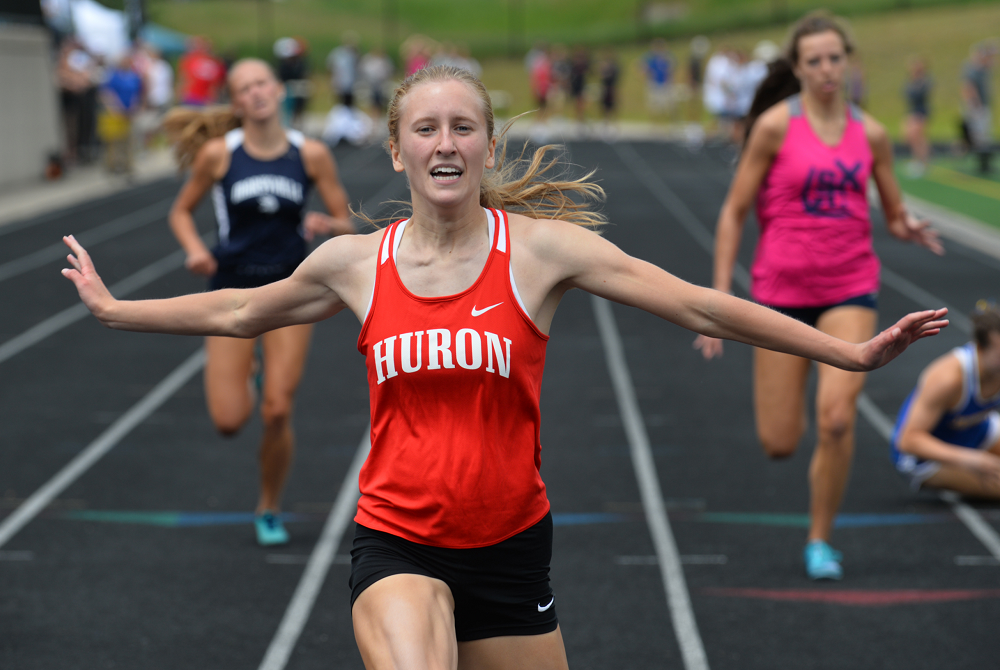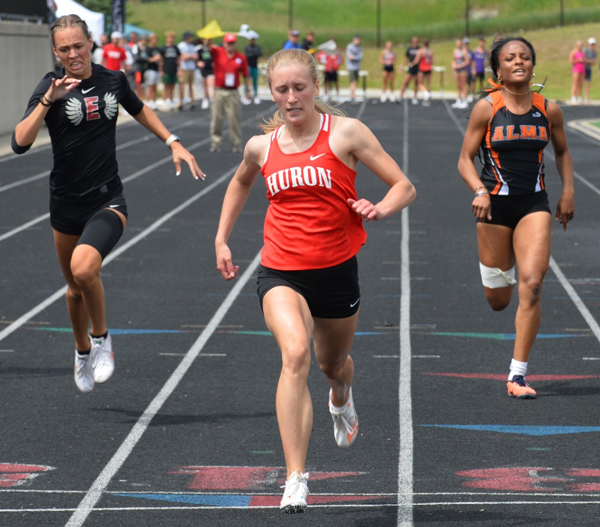
Record Highlights Pioneer Title Chase
By
Paul Costanzo
Special for MHSAA.com
June 3, 2017
EAST KENTWOOD – The afternoon running finals of the Division 1 Girls Track & Field Finals needed just 13.4 seconds Saturday afternoon to become record breaking.
Ann Arbor Pioneer junior Britten Bowen won the 100-meter hurdles in 13.40 seconds, setting the meet and all-Finals records (formerly set by Pioneer star Candice Davis in 2003), edging White Lake Lakeland’s Grace Stark, who also had beaten that former record time only a week ago.
“My coach (Bryan Westfield) passed away two years ago, and I lost it indoors, and I was trying to bring it back for him,” an emotional Bowen said. “I trained really, really hard this year for this. I wanted to leave it all on the track.”
Bowen’s hurdles title was one of three championships for the Pioneers, who claimed their first MHSAA Finals team title since 2008 by edging three-time defending champion Oak Park. Pioneer finished with 69 points, four ahead of Oak Park. East Kentwood was third on its home track, finishing with 57 points.
It was the 17th team title for the Pioneers, the previous 16 coming under Westfield.
“The kids really, really rallied, and I can’t believe we did this,” Pioneer coach Nancy Boudreau said. “We had a lot of kids that were nicked up, and we had to make substitutions at the last minute, and we still pulled it off, which is really unbelievable.”
Bowen’s record-breaking performance wasn’t Pioneer’s first of the day, as Anne Forsyth, Elizabeth Kos, Sydney Dawes and Jacalyn Overdier won the 3,200-meter relay with a time of 9:06.13 in the morning session. The Pioneers won despite having to scratch all-state 800-meter runner Alice Hill prior to the race.
Forsyth was a double winner on the day, finishing first in the 1,600 in 4:43.84.
Bowen’s race was a big boost, however, energizing the team as the main portion of the meet began. It was a much-anticipated race, as her and Stark were lined up next to each other.
“It pushed me even harder,” Bowen said of racing next to Stark. “She beat me during indoors, and that was all I was focusing on: ‘I just need to run my race. I know what I need to do. She’s going to do what she’s going to do, and it’s going to be a race.’ And that’s what it was. And that’s what people have been talking about all year, so that’s what we did: we gave them a race.”
Bowen’s record-breaking performance was one of three on the day in the girls meet. Angelica Floyd of Clinton Township Chippewa Valley set the Division 1 meet record in the long jump with a distance of 19 feet, 3¾ inches.
Kyanna Evans of Wyandotte Roosevelt set the Division 1 meet record winning the 300 hurdles in 42.64 seconds. Evans said it was her first time breaking 45 in the race.
“I didn’t think I could do it, I really didn’t,” Evans said. “I’ve been struggling to break 45 for so long. I just went out and sprinted and did what I needed to do. I just told myself I was going to go 100 percent. It’s my last time running the 300-meter hurdles.”
Tamea McKelvy did her part for runner-up Oak Park, winning three titles, including an individual in 200 meters. She crossed the line in 24.14 seconds, and talked through tears of joy following the race.
“My first individual state championship. I’m so happy,” McKelvy said. “It was my last time wearing this uniform, and I wanted to get that fourth straight win for my team. I’ve been thinking about this since last season when I lost.”
McKelvy joined Janae Barksdale and Aasia Laurencin on both the 400 and 800 relay teams. Kirin Tate joined that trio on the winning 400 relay (46.69), while Carlita Taylor was the fourth member of the 800 relay (1:38.38).
Oak Park’s 1,600 relay also brought home the gold, as Taylor, Drew Coleman, Makayla Gate and Miyah Brooks won in 3:49.73.
Flushing’s Breanna Perry won her second MHSAA title in three months by taking first in the high jump at 5-foot-7. Perry was a crucial part of Flushing’s Class A girls basketball championship team.
“It was really fun to win with my team, but I just wanted to be able to go home and be like, ‘I worked hard on this on my own and with my coach,’” Perry said. “This is something I can call mine. This is my championship, so it feels pretty good.”
Greenville’s Landon Kemp repeated in the pole vault, clearing 13-3, one inch shy of her record-setting performance from a year ago.
Corrine Jemison of East Kentwood won the discus with a throw of 151 feet, while Aniya Davis of Grand Rapids Ottawa Hills won the shot put with a throw of 40-10½.
Anavia Battle of Wayne Memorial won the 100 meters in 11.95. Taylor Manson of East Lansing won the 400 meters in 53.21. Mallory Barrett of Milford won the 800 in 2:11.06. Maggie Farrell of Battle Creek Lakeview won the 3,200 meters in 10:19.99.
PHOTO: Ann Arbor Pioneer's Britten Bowen, center, sets an MHSAA hurdles record Saturday while pushed by a strong field including Lakeland's Grace Stark, right. (Photo by Carter Sherline/RunMichigan.com.)

Multi-Sprint Champ Racing to Finish Huron Career Ahead of the Rest Again
By
Keith Dunlap
Special for MHSAA.com
May 25, 2023
NEW BOSTON – If there was one thing Elizabeth Anderson took pride in elementary school, it was simply showing that she could outrun everyone in sight.
 In fact, Anderson has an explanation for all the success she had in those playground races.
In fact, Anderson has an explanation for all the success she had in those playground races.
“Dominance when you are in elementary school,” Anderson quipped. “I don’t think I ever had a nickname. I just think everyone knew I was fast.”
Years later, pretty much everyone who follows track & field in the state of Michigan can attest to that.
A senior for New Boston Huron, Anderson has been faster than most other competitors in the state during her three-year high school career (with her freshman season in 2020 canceled due to COVID-19).
Last year, Anderson won titles at the Lower Peninsula Division 2 Finals in the 200-meter (25.07) and 400-meter (56.28) dashes, and was runner-up in the 100-meter dash (12.23).
Often, top sprinters focus on one or two of those three races. But Anderson is certainly a different breed of sprinter because she does all three.
In fact, she holds school records in all three of those events, and if all that weren’t enough, Anderson is a part of all three sprint relay teams.
“It is hard to give her events off,” said New Boston Huron head girls track coach Danielle Lobato.
Despite the different styles the 100, 200 and 400-meter dashes present, Anderson said there usually isn’t much adjusting when she goes from one of those races to another.
 The strategy is simply, “Let’s beat the other girls to the finish line.”
The strategy is simply, “Let’s beat the other girls to the finish line.”
“I don’t really go into each race changing up how I would run,” she said.
While enjoying and succeeding in all three races, Anderson said she actually does have a favorite among them.
“I would say the 400 is probably my favorite,” she said. “Even though it hurts, it’s satisfying to see how much you can get your time down in the 400 compared to any other race.”
Anderson said she started running track in sixth grade, but really got serious about it during the summer after her sophomore season, when she was invited to run for a local club.
Eventually, that led to her competing over the winter in indoor events.
She lived and breathed track so much that last fall, she decided to not run cross country so she could focus on a weightlifting regimen aimed at developing more leg strength.
“Once I started doing summer track, I realized I wanted to be doing this all the time,” she said.
Lobato said oftentimes in practice, Anderson is a de facto coach, given there is no better person she can think of for the younger runners on the team to learn from.
“I can’t always demonstrate these things I’m trying to teach,” she said. “You get to see it in real life (from Anderson), not in a YouTube video.”
After winning the 100, 200 and 400-meter dashes at her Regional meet last week, Anderson has her sights set on achieving the same trifecta of titles at next Saturday’s Finals in Grand Rapids.
Anderson has signed to run track at Michigan State, but has been plenty motivated to keep producing this spring in her final high school season.
“I’m really looking to defend my titles,” she said. “That is what is really motivating me to keep going. I want to keep in shape for the college season. I don’t want to lose any of the progress I have made. Ultimately, I just love running track.”
And since elementary school, Anderson has loved — and succeeded in — outrunning everyone else to the finish line.
“We knew we were getting something special,” Lobato said of when Anderson arrived in high school. “But you never expect this. All that she has accomplished is amazing.”
 Keith Dunlap has served in Detroit-area sports media for more than two decades, including as a sportswriter at the Oakland Press from 2001-16 primarily covering high school sports but also college and professional teams. His bylines also have appeared in USA Today, the Washington Post, the Detroit Free Press, the Houston Chronicle and the Boston Globe. He served as the administrator for the Oakland Activities Association’s website from 2017-2020. Contact him at [email protected] with story ideas for Oakland, Macomb and Wayne counties
Keith Dunlap has served in Detroit-area sports media for more than two decades, including as a sportswriter at the Oakland Press from 2001-16 primarily covering high school sports but also college and professional teams. His bylines also have appeared in USA Today, the Washington Post, the Detroit Free Press, the Houston Chronicle and the Boston Globe. He served as the administrator for the Oakland Activities Association’s website from 2017-2020. Contact him at [email protected] with story ideas for Oakland, Macomb and Wayne counties
PHOTOS (Top) New Boston Huron's Elizabeth Anderson clears the finish line during last season's LPD2 400 race. (Middle) Anderson, middle, outpaces the field to also win the 200. (Click for more from RunMichigan.com.)

